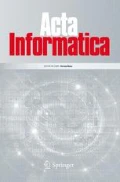Abstract
Recently we have considered the possibility of using bio-inspired mobility for solving a weak NP-complete problem (Partition). In this paper we provide a semi-uniform polynomial solution for a strong NP-complete problem (Bin Packing) by means of membrane computing techniques. The solution employs mobile membranes and elementary membrane division.
Similar content being viewed by others
Notes
A membrane system without membrane division can be simulated by a Turing machine with a polynomial slowdown [12].
References
Aman, B., Ciobanu, G.: Turing completeness using three mobile membranes. Lect. Notes Comput. Sci. 5715, 42–55 (2009)
Aman, B., Ciobanu, G.: Simple, enhanced and mutual mobile membranes. Trans. Comput. Syst. Biol. XI, 26–44 (2009)
Aman, B., Ciobanu, G.: Solving a weak NP-complete problem in polynomial time with mutual mobile membrane systems. Acta Inf. 48(7–8), 409–415 (2011)
Aman, B., Ciobanu, G.: Mobility in Process Calculi and Natural Computing. Natural Computing Series. Springer, New York (2011)
Garey, M., Johnson, D.: Computers and Intractability. A Guide to the Theory of NP-Completeness. Freeman, New York (1979)
Păun, G.H.: Membrane Computing. An Introduction. Springer, New York (2002)
Păun, G.H., Rozenberg, G., Salomaa, A. (eds.): The Oxford Handbook of Membrane Computing. Oxford University Press, Oxford (2010)
Pérez-Jiménez, M.J.: An approach to computational complexity in membrane computing. Lect. Notes Comput. Sci. 3365, 85–109 (2005)
Pérez-Jiménez, M.J., Riscos-Núñez, A., Romero-Jiménez, A., Woods, D.: Complexity-Membrane Division, Membrane Creation. Păun, G.H., Rozenberg, G., Salomaa, A. (eds.): The Oxford Handbook of Membrane Computing, pp 302–336. Oxford University Press, Oxford (2010)
Porreca, A.E., Leporati, A., Mauri, G., Zandron, C.: Elementary active membranes have the power of counting. Int. J. Nat. Comput. Res. 2(3), 329–342 (2011)
Sosk, P.: The computational power of cell division in P systems: beating down parallel computers? Nat. Comput. 2(3), 287–298 (2003)
Zandron, C., Ferretti, C., Mauri, G.: Solving NP-complete problems using P systems with active membranes. In: Antoniou, I., Calude, C.S., Dinneen M.J. (eds.) Unconventional Models of Computation, pp. 289–301. Springer, New York (2001)
Acknowledgments
The work was supported by a grant of the Romanian National Authority for Scientific Research, Project Number PN-II-ID-PCE-2011-3-0919.
Author information
Authors and Affiliations
Corresponding author
Additional information
Dedicated to the 150th anniversary of the Romanian Academy.
Rights and permissions
About this article
Cite this article
Aman, B., Ciobanu, G. Efficiently solving the Bin Packing problem through bio-inspired mobility. Acta Informatica 54, 435–445 (2017). https://doi.org/10.1007/s00236-016-0264-3
Received:
Accepted:
Published:
Issue Date:
DOI: https://doi.org/10.1007/s00236-016-0264-3




